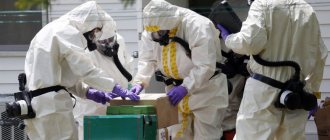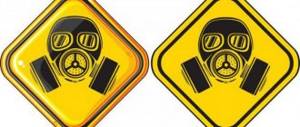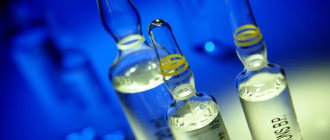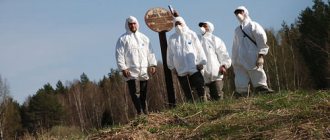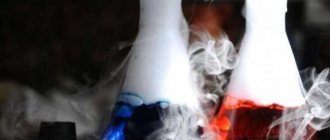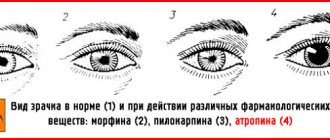Mustard, bis(2-chloroethyl) sulfide is an organosulphuric compound with the composition (ClCH 2 CH 2) 2 S. Mustard was first obtained by the German chemist Victor Meer in 1886. This was preceded by the work of chemists Despres (1822), Neman (1859), Gutman (1860), who studied this class of compounds, but did not isolate it in its pure form.
Pure mustard gas is a colorless, odorless, oily substance (technical mustard gas has a garlic-mustard odor and a yellow-brown color). It is poorly soluble in water and unlimited in many organic solvents.
During the First World War, mustard gas was used as a chemical warfare agent with blister action. The international designation of mustard gas as a chemical weapon is HD. Ammunition with mustard gas in Germany was marked with a yellow cross (it is part of the yellow cross combat mixture, German Gelbkreuz), in the USA it is coded with two green rings.
In 1993, as a result of the signing of the Chemical Weapons Convention, the use of mustard gas as a chemical weapon was prohibited. It was included in List 1, which regulates the production and circulation of hazardous substances.
The term mustard gas comes from the name of the Belgian city of Ypres, near which on the night of July 13, 1917, German troops first used this substance as a chemical weapon.
The toxic effect of mustard gas is damage to the eyes, skin, and respiratory tract. Symptoms of poisoning appear with a latent period of 2:00, but in hot weather and wet skin they appear immediately. Contact with the substance results in the appearance of bubbles with a yellowish liquid, which take a long time to heal and leave scars. With a concentration of mustard gas in the air of 0.03 mg/l, death occurs within 2-5 minutes.
The substance quickly penetrates building materials and is absorbed by textiles, rubber, and paper, so poisoning is also possible through contact with contaminated objects.
History[ | ]
It was synthesized by Cesar Despres in 1822 and (independently) by British scientist Frederick Guthrie in 1860.[1]
Initially, the substance was given the name Lost - an abbreviation for the names of scientists Wilhelm Lommel and Wilhelm Steinkopf[en], who created a method for its production on an industrial scale for the German Imperial Army in 1916[2].
Mustard gas was first used by Germany on July 12, 1917 against Anglo-French troops, who were fired at by mines containing an oily liquid near the Belgian city of Ypres (where the name of this substance came from)[3].
In addition, mustard gas was used in the Italo-Ethiopian War of 1935-1936.
In December 1943, as a result of the bombing of the city of Bari by German aircraft, the American transport John Harvey, carrying mustard gas bombs, was sunk. As a result of the gas leak, a large number of American sailors and local residents were poisoned, some of them fatal[4].
Story
It was synthesized by Cesar Despres in 1822 and (independently) by British scientist Frederick Guthrie in 1860.[1]
Initially, the substance was given the name Lost - an abbreviation for the names of scientists Wilhelm Lommel and Wilhelm Steinkopf[en], who created a method for its production on an industrial scale for the German Imperial Army in 1916[2].
Mustard gas was first used by Germany on July 12, 1917 against Anglo-French troops, who were fired at by mines containing an oily liquid near the Belgian city of Ypres (where the name of this substance came from)[3].
In addition, mustard gas was used in the Italo-Ethiopian War of 1935-1936.
In December 1943, as a result of the bombing of the city of Bari by German aircraft, the American transport John Harvey, carrying mustard gas bombs, was sunk. As a result of the gas leak, a large number of American sailors and local residents were poisoned, some of them fatal[4].
Receiving[ | ]
Mustard gas is produced in three ways:
- From ethylene and sulfur chlorides, such as S2Cl2 or SCl2:
2 CH 2 = CH 2 + SC l 2 → ( CH 2 C l - CH 2 ) 2 S {\displaystyle {\mathsf {2CH_{2}{\text{=}}CH_{2}+SCl_{2}\ rightarrow (CH_{2}Cl{\text{-}}CH_{2})_{2}S}}}
- From thiodiglycol S(CH2CH2OH)2 and phosphorus trichloride PCl3:
3 ( HO - CH 2 - CH 2 ) 2 S + 2 PC l 3 → 3 ( CH 2 C l - CH 2 ) 2 S + 2 H 3 PO 3 {\displaystyle {\mathsf {3(HO{\text{ -}}CH_{2}{\text{-}}CH_{2})_{2}S+2PCl_{3}\rightarrow 3(CH_{2}Cl{\text{-}}CH_{2}) _{2}S+2H_{3}PO_{3}}}}
- From thiodiglycol and hydrochloric acid:
( HO - CH 2 - CH 2 ) 2 S + 2 HC l → ( CH 2 C l - CH 2 ) 2 S + 2 H 2 O {\displaystyle {\mathsf {(HO{\text{-}}CH_{ 2}{\text{-}}CH_{2})_{2}S+2HCl\rightarrow (CH_{2}Cl{\text{-}}CH_{2})_{2}S+2H_{2 }O}}}
Receipt
Mustard gas is produced in three ways:
- From ethylene and sulfur chlorides, such as S2Cl2 or SCl2:
2 CH 2 = CH 2 + SC l 2 → ( CH 2 C l - CH 2 ) 2 S {\displaystyle {\mathsf {2CH_{2}{\text{=}}CH_{2}+SCl_{2}\ rightarrow (CH_{2}Cl{\text{-}}CH_{2})_{2}S}}}
- From thiodiglycol S(CH2CH2OH)2 and phosphorus trichloride PCl3:
3 ( HO - CH 2 - CH 2 ) 2 S + 2 PC l 3 → 3 ( CH 2 C l - CH 2 ) 2 S + 2 H 3 PO 3 {\displaystyle {\mathsf {3(HO{\text{ -}}CH_{2}{\text{-}}CH_{2})_{2}S+2PCl_{3}\rightarrow 3(CH_{2}Cl{\text{-}}CH_{2}) _{2}S+2H_{3}PO_{3}}}}
- From thiodiglycol and hydrochloric acid:
( HO - CH 2 - CH 2 ) 2 S + 2 HC l → ( CH 2 C l - CH 2 ) 2 S + 2 H 2 O {\displaystyle {\mathsf {(HO{\text{-}}CH_{ 2}{\text{-}}CH_{2})_{2}S+2HCl\rightarrow (CH_{2}Cl{\text{-}}CH_{2})_{2}S+2H_{2 }O}}}
Physical properties[ | ]
Mustard gas is a colorless liquid with the smell of garlic or mustard. Technical mustard gas is a dark brown, almost black liquid with an unpleasant odor. Melting point is 14.5 °C, boiling point is 217 °C (with partial decomposition), density is 1.280 g/cm³ (at 15 °C).
Mustard gas dissolves easily in organic solvents - halogenated alkanes, benzene, chlorobenzene - just as well as in vegetable or animal fats; solubility in water is 0.05%. While the solubility in absolute ethanol above 16 °C is almost 100%, in 92% ethanol it barely reaches 25%.
Due to some surface activity, it reduces the surface tension of water and to a small extent spreads over it in a thin layer, like a film of oil. As a result of adding 1% high-molecular amine C22H38O2NH2, the spreading of mustard gas through water increases by 39%.
Mustard gas hydrolyzes very slowly with water; the rate of hydrolysis increases sharply in the presence of caustic alkalis, with heating and stirring.
Mustard gas reacts vigorously with chlorinating and oxidizing agents. Since this produces non-toxic products, the above reactions are used to degas it. With salts of heavy metals, mustard gas forms complex colored compounds; The detection of mustard gas is based on this property.
Chemical properties
Mustard gas slowly hydrolyzes to form hydrochloric acid and thiodiglycol:
It is slightly soluble in water, so it may not experience hydrolysis for a long time. The hydrolysis process is accelerated by increased temperature and the presence of alkalis.
One of the most important reactions is the action of methenamine during hydrolysis: the product of the interaction of the hydrochloric acid created with methenamine is formaldehyde, which promotes wound healing:
Under the action of strong oxidizing agents (potassium permanganate, chromate acid, nitric acid, hypochlorites), sulfide is oxidized to sulfoxide, and then to sulfone:
Despite the fact that oxidation products are also toxic substances, this method is used for degassing because they are crystalline substances and do not affect the skin.
Like other thiethers, mustard gas is capable of forming sulfonium compounds with metal salts. The complexes formed have a characteristic color and sometimes low solubility; therefore, they are sometimes used in analytical chemistry. More often the reaction is carried out with heavy metal halides: iodides and chlorides of copper, zinc, titanium, platinum, aura:
Chemical properties[ | ]
At ordinary temperatures, mustard gas is a stable compound. When heated above 170 °C, it decomposes to form unpleasant-smelling, toxic products of various compositions. At temperatures above 500 °C, complete thermal decomposition occurs. Short-term heating even above 300 °C leads to almost no formation of decomposition products, therefore mustard gas is considered relatively resistant to detonation.
In relation to metals at ordinary temperatures, mustard gas is inert; it has almost no effect on lead, brass, zinc, steel, aluminum; When the temperature rises, the steel breaks down. Contaminated mustard gas, which usually contains water and hydrogen chloride, causes corrosion of steel. The resulting iron salts promote corrosion. Due to the gases released (hydrogen, hydrogen sulfide, ethylene and other decomposition products), an increase in pressure in closed containers, mines, bombs and transport containers must be taken into account.
Corrosion inhibitors and antioxidants prevent decomposition during storage. Such substances can be, for example, tetraalkylammonium halides, hexamethylenetetramine, pyridine, picoline, quinoline and other organic amino derivatives.
In the human body, mustard gas reacts with alkylation with NH groups of nucleotides that are part of DNA. This promotes the formation of cross-links between DNA strands, which makes this section of DNA inoperable.
[edit] First aid for mustard gas damage
There is no antidote for mustard gas poisoning. Drops of mustard gas on the skin must be immediately washed off using an individual anti-chemical bag. The eyes and nose should be rinsed generously, and the mouth and throat should be rinsed with a 2% solution of baking soda or clean water. In case of poisoning with water or food contaminated with mustard gas, induce vomiting and then administer a slurry prepared at the rate of 25 g of activated carbon in 100 ml of water. Ulcers formed due to drops of mustard gas getting on the skin should be treated with potassium permanganate (potassium permanganate KMnO4).
Varieties and analogues[ | ]
The following substances with the name “mustard gas” can be used as chemical warfare agents[5][6][7]:
- Mustard gas itself (sulfur mustard, HS)
- distilled mustard gas (HD) - bis(2-chloroethyl) sulfide, mustard gas purified from sulfur-containing impurities
- Levinshtein mustard (Agent H) - 70% distilled mustard + 30% sulfur impurities
- Zaikova's mustard gas - the ethyl group is replaced by a propyl group, has higher volatility (tmelt. < 0 ° C) than sulfur mustard and is used at low air temperatures
- sesquimustard (Q) - has lower volatility (tmelt. = 56.5 °C) than sulfur mustard and is used in a mixture with it at high air temperatures
- oxygen mustard (T) - bis[2-(2-chloroethylthio)ethyl] ether, has lower volatility (tmelt. = -10 ° C) than sulfur mustard and is used in a mixture with it at high air temperatures
- thickened mustard gas (W) - a mixture of sulfur mustard with a thickener (for example, polymethyl methacrylate with Mr ≈ 50 kDa), it is also possible to add lewisite (L)
- nitrogen mustards - 2-chloro-substituted alkylamines, structurally and toxic properties similar to sulfur mustard
Damaging effect[ | ]
Forms of application of mustard gas: air-droplet and liquid-droplet. When affected by airborne mustard gas, the respiratory organs are predominantly affected (laryngo-tracheitis, tracheo-bronchitis, broncho-pneumonia); when affected by liquid mustard gas - skin manifestations (erythema, vesicles, bullae, ulcers, necrosis).
Canadian soldier after poisoning with mustard gas. Ulcerations and detachment of the mucous membrane of the larynx and trachea affected by mustard gas fumes. Drawing of a horse affected by mustard gas - in the affected areas, hair loss, inflammation and deep skin ulcers
Mustard gas affects the human body in several ways:
- destruction of cell membranes;
- carbohydrate metabolism disorder;
- “tearing out” nitrogenous bases from DNA and RNA.
Mustard gas has a damaging effect through any route of entry into the body. Damage to the mucous membranes of the eyes, nasopharynx and upper respiratory tract occurs even at low concentrations of mustard gas. At higher concentrations, along with local lesions, general poisoning of the body occurs. Mustard gas has a latent period of action (2-8 hours) and is cumulative.
At the time of contact with mustard gas, there is no skin irritation or pain effects. Areas affected by mustard gas are prone to infection. Skin damage begins with redness, which appears 2-6 hours after exposure to mustard gas. After a day, small blisters filled with a yellow transparent liquid form at the site of redness, which subsequently merge. After 2-3 days, the blisters burst and an ulcer forms, healing only after 20-30 days. If the ulcer becomes infected, healing may take up to 2-3 months.
When inhaling mustard gas vapors or aerosols, the first signs of damage appear after a few hours in the form of dryness and burning in the nasopharynx, then severe swelling of the nasopharyngeal mucosa occurs, accompanied by purulent discharge. In severe cases, pneumonia develops, and death occurs on the 3-4th day from suffocation.
The eyes are especially sensitive to mustard vapors. When exposed to mustard gas vapors on the eyes, a feeling of sand appears in the eyes, lacrimation, photophobia, then redness and swelling of the mucous membrane of the eyes and eyelids occurs, accompanied by copious discharge of pus.
Contact with droplets of liquid mustard gas in the eyes can lead to blindness. When mustard gas enters the gastrointestinal tract, sharp pain in the stomach, drooling, nausea, vomiting, and melena appear within 30-60 minutes.
It is interesting to note the statements of V. Meyer (Meyer V. [8]), who obtained mustard gas in its pure form in 1886:
At first I was inclined to believe that the phenomena observed under the action of chloride should be explained by the special susceptibility of the experimenter; however, as a result of experiments carried out at my request at the local physiological institute, I realized something more important. According to these experiments, this compound has highly dangerous properties, as could be concluded from preliminary reports, limited to the most important and striking observations.
Each of the medium-sized rabbits was placed twice for 3-4 hours in a locked cage, ventilated with a strong air flow. Before entering the cell, the air flow passed through a glass tube containing strips of filter paper moistened with 2,2′-dichlorodiethyl sulfide. The animals were excited, often touching their nose and muzzle with their paws, which had a characteristic bright red color. The conjunctiva also turned red, and the eyes were very wet. Skin moisture production has increased noticeably. The next day, the eyes became very inflamed, the eyelids were stuck together with purulent discharge. A severe runny nose appeared, the ears became very swollen, and purulent inflammation appeared in the ear canal. By the evening of the third day, the animals died of acute pneumonia, which had spread to both lungs. One very strong rabbit, which had inhaled vapors of the substance for several hours through the opening of the air tube, so that they did not act on the surface of the body, died in the evening of the same day from developing pneumonia, so there was no time for other symptoms to appear.
In rabbits in which a small amount of dichlorodiethyl sulfide was applied to the intact skin of the tips of the ears using a thin brush, no traces of damage appeared at the site of application, but the entire ear became very swollen, and in one case, profuse purulent inflammation arose from the base of the ear canal to the outer part of the ear. The possibility of the drug flowing into the ear canal was excluded partly due to the small amount of substance applied with a brush, partly due to the fact that the drug was applied to the outer surface of the ear. In the case where the skin was previously exposed by shaving the hair from the tips of the ears, the drug applied with a brush, of course, caused preferential suppuration in this place, but at the same time more severe swelling of the entire ear and inflammation of the eyes. When approximately two drops of the drug were injected subcutaneously into a scratch on the skin of a rabbit's back, inflammation of both eyes occurred, a very severe runny nose, and on the third day death occurred due to pneumonia. There were no signs of damage at the site of application of the drug. Since the vapors of the substance had a harmful effect on the experimenter, similar to that briefly described above, these experiments had to be stopped.
The minimum dose that causes the formation of abscesses on the skin is 0.1 mg/cm². Mild eye damage occurs at a concentration of 0.001 mg/l and exposure for 30 minutes. The lethal dose when exposed through the skin is 70 mg/kg (latent period of action up to 12 hours or more). The lethal concentration when exposed through the respiratory system for 1.5 hours is about 0.015 mg/l (latent period 4-24 hours).
First aid for mustard gas injury[ | ]
There is no antidote for mustard gas poisoning. According to the experience of doctors of the First World War, the primary role should be given to primary sanitary treatment (there is no clinic, as such, in case of mustard gas damage in the first hours after the injury). Drops of mustard gas on the skin must be immediately degassed using an individual anti-chemical bag. The eyes and nose should be rinsed generously, and the mouth and throat should be rinsed with a 2% solution of baking soda or clean water. It is strictly prohibited to treat leather with solvents (for example, kerosene). Due to the high solubility of mustard gas in organic solvents, its penetration into the thickness of the skin in this case will be noticeably faster, and the ulcerative-necrotic stage of the lesion will develop faster. In case of poisoning with water or food contaminated with mustard gas, induce vomiting, and then introduce a slurry (the so-called “chatter”) prepared at the rate of 25 grams of activated carbon per 100 ml of water. In the vesicular-bullous stage, the blisters should be opened, and in place of the opened blister, a bandage should be placed, abundantly moistened with a chloramine solution. Ulcers caused by drops of mustard gas on the skin should be treated like burns.
Protective means[ | ]
To protect the respiratory system and skin from the action of mustard gas, a gas mask and special protective clothing are used, respectively. Since mustard gas has the ability to diffuse into complex organic compounds, it should be remembered that an OZK and a gas mask do not guarantee complete protection of the skin. The time spent in the affected area by mustard gas should not exceed 40 minutes to avoid penetration through protective equipment to the skin.
Toxicity
Mustard gas acts on the human body or is an inhalation and contact poison: drops and aerosols of mustard gas affect the respiratory tract, skin, and eyes.
The substance can penetrate the body through the skin. This ability depends on the ambient temperature: at 21-23 ° C penetration is 1.4 10 -3 mg / (cm² min), at high temperatures it is about 2.7 10 -3 mg / (cm² min). Penetration of mustard gas into the body in an amount of 6 · 10 -3 in half of the cases causes the appearance of blisters. The formation of small erythemas occurs at a dose of 0.01 mg/cm of skin, large ones - at a dose of 0.5 mg/cm. The eyes are affected even by low concentration mustard gas: its effect is at a concentration of 1.2 × 10 -3 mg/l for 45 minutes causes eye inflammation, eyelid spasms, photophobia, which lasts up to 4 weeks.
The effect of mustard gas at a concentration of 0.03 mg/l for 2-5 minutes is lethal. A concentration of 0.01 mg/l is dangerous within 15 minutes and leads to severe damage to the eyes and skin.
Contact of mustard gas on the skin initially does not cause any discomfort. During the first 2-5 minutes, it penetrates the skin, then dissolves in subcutaneous fat and subsequently, after 20-30 minutes, is completely absorbed and enters the blood. After absorption, a latent period begins, lasting from 2:00 to a day, depending on the dose, temperature and humidity, structure and moisture of the skin. In hot weather, with hot, damp skin or its tender areas, the period of latent action is significantly reduced and may be almost absent.
The first signs of damage after the end of the period of latent action appear in the form of itching, burning and redness of the skin (erythema) in areas of contact with liquid or gaseous mustard gas. The skin tightens, becomes dry and warm. With small doses, these phenomena disappear after a few days. At higher doses, swelling develops, along the edges of which, 16-30 hours after contact with the poison, many small bubbles appear. Subsequently, they merge into large or one large bubble with a colorless or yellowish liquid. The blisters burst and painful mustard ulcers form on the skin, the healing of which can take more than 2 months. Secondary infection can lead to purulent inflammation of the affected areas of the skin. Scars remain in their place.
Protection
The main protection against mustard gas, in particular the eyes, face and respiratory tract, is a gas mask. After contact with cotton clothing, mustard gas completely saturates it within 3:00, which can subsequently lead to additional damage. To prevent the compound from getting on and under clothing, use special protective suits.
To treat skin (eliminate small drops of mustard gas), clothing or items that have been in contact with mustard gas, oxidizing agents and chlorination agents (hypochlorites, bleach, chloroamides) are used.
Notes[ | ]
- Frederick Guthrie.
XIII.—On some derivatives from the olefines (English) // Journal of the Chemical Society (English) Russian. - Chemical Society, 1860. - Vol. 12, no. 1. - P. 109-126. - doi:10.1039/QJ8601200109. - Fischer, Karin.
Steinkopf, Georg Wilhelm, in: Sächsische Biografie (German) / Schattkowsky, Martina. — Online. — Institut für Sächsische Geschichte und Volkskunde, 2004. - Franke Z.
Chemistry of toxic substances. M., "Chemistry", 1973, vol. 1, p. 136 - Academy of the State Fire Service of the Ministry of Emergency Situations of Russia Archived copy of October 29, 2020 on the Wayback Machine
- Classification of toxic substances (CS) // Article in No. 3 of 2002 of the journal “Chemical and Biological Safety”.
- Terms and concepts used in the field of chemical and biological safety // Article in No. 4-5 of 2002 of the journal “Chemical and Biological Safety”.
- Antonov N. S.
Chemical weapons at the turn of two centuries / section “Major milestones in the development of chemical weapons” // M.: Progress. 1994. - 174 p. (pp. 28-30). ISBN 01-004462-5. - Meyer V., Chem. Ber., Bd. 19, s. 326 (1886).
Notes
- Frederick Guthrie.
XIII.—On some derivatives from the olefines (English) // Journal of the Chemical Society (English) Russian. - Chemical Society, 1860. - Vol. 12, no. 1. - P. 109-126. - doi:10.1039/QJ8601200109. - Fischer, Karin.
Steinkopf, Georg Wilhelm, in: Sächsische Biografie (German) / Schattkowsky, Martina. — Online. — Institut für Sächsische Geschichte und Volkskunde, 2004. - Franke Z.
Chemistry of toxic substances. M., "Chemistry", 1973, vol. 1, p. 136 - Academy of the State Fire Service of the Ministry of Emergency Situations of Russia Archived copy of October 29, 2020 on the Wayback Machine
- Classification of toxic substances (CS) // Article in No. 3 of 2002 of the journal “Chemical and Biological Safety”.
- Terms and concepts used in the field of chemical and biological safety // Article in No. 4-5 of 2002 of the journal “Chemical and Biological Safety”.
- Antonov N. S.
Chemical weapons at the turn of two centuries / section “Major milestones in the development of chemical weapons” // M.: Progress. 1994. - 174 p. (pp. 28-30). ISBN 01-004462-5. - Meyer V., Chem. Ber., Bd. 19, s. 326 (1886).
Literature[ | ]
- Franke Z.
Chemistry of toxic substances: In 2 volumes = Lehrbuch der Militarchemie: Band 1, 2 / Siegfried Franke; Per. with him.. - M.: Chemistry, 1973. - T. 1. - P. 136-166. — 440 s. - Soborovsky L. Z., Epshtein G. Yu.
Chemistry and technology of chemical warfare agents / L. Z. Soborovsky and G. Yu. Epshtein; The chapter “Smoke-forming substances” was written by N. I. Mokeev. - M.; L.: NKOP USSR. State Publishing house of the defense industry, 1938. - 587 p. - Sartori M.
New in the chemistry of chemical warfare agents / Sartori Mario // Advances in chemistry. 1954. T. 21, century. 1. P. 62. - Kutsenko S. A., Butomo N. V., Grebenyuk A. N., Ivnitsky Yu. Yu., Melnichuk V. P.
Military toxicology, radiobiology and medical protection: Textbook for universities / Ed. S. A. Kutsenko. - St. Petersburg: Foliant, 2004. - 528 p. — 10,000 copies. — ISBN 5-93929-082-5. - Petrenko E. P.
Military toxicology, radiobiology and medical protection: Textbook. - Saratov, 2007. - 368 p.
Literature
- Franke Z.
Chemistry of toxic substances: In 2 volumes = Lehrbuch der Militarchemie: Band 1, 2 / Siegfried Franke; Per. with him.. - M.: Chemistry, 1973. - T. 1. - P. 136-166. — 440 s. - Soborovsky L. Z., Epshtein G. Yu.
Chemistry and technology of chemical warfare agents / L. Z. Soborovsky and G. Yu. Epshtein; The chapter “Smoke-forming substances” was written by N. I. Mokeev. - M.; L.: NKOP USSR. State Publishing house of the defense industry, 1938. - 587 p. - Sartori M.
New in the chemistry of chemical warfare agents / Sartori Mario // Advances in chemistry. 1954. T. 21, century. 1. P. 62. - Kutsenko S. A., Butomo N. V., Grebenyuk A. N., Ivnitsky Yu. Yu., Melnichuk V. P.
Military toxicology, radiobiology and medical protection: Textbook for universities / Ed. S. A. Kutsenko. - St. Petersburg: Foliant, 2004. - 528 p. — 10,000 copies. — ISBN 5-93929-082-5. - Petrenko E. P.
Military toxicology, radiobiology and medical protection: Textbook. - Saratov, 2007. - 368 p.
